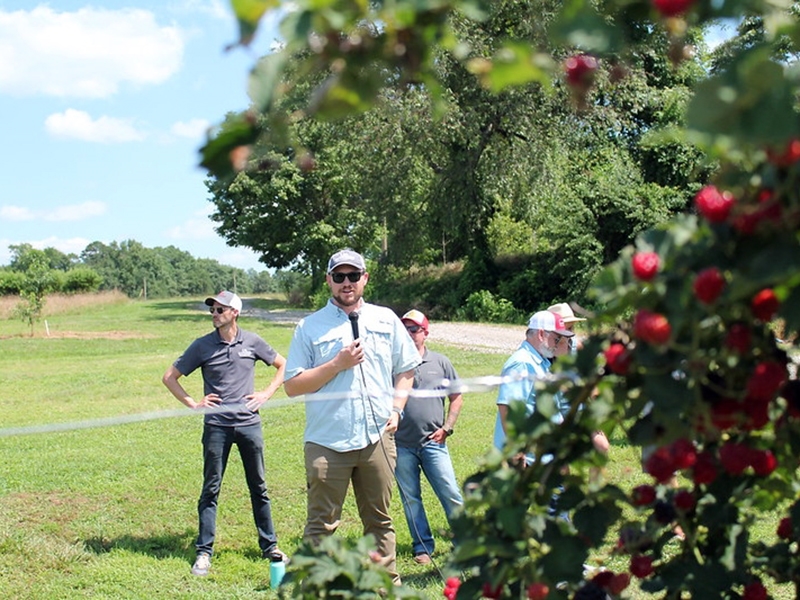Listen: Optimizing Blackberry Pest Management: The Impact of RCA Trellising and Spray Coverage


Blackberry Pest Management Research Highlights Importance of Sustainable Development Goals
June 26, 2024

Aaron Cato, extension IPM specialist, speaks during the 2024 Blackberry Field Day at the Fruit Research Station in Clarksville (U of A System Division of Agriculture photo).
It’s blackberry season in Arkansas, and the spotted-wing drosophila, an invasive fruit fly, has already been spotted in blackberry fields. This non-native species can cause significant problems for blackberry growers. New research is shedding light on a trellising system that could enhance pest management against spotted-wing drosophila.
In the latest episode of Food, Farms & Forests, Aaron Cato explains research that shows the rotating cross-arm (RCA) trellis offers better spray coverage than the more commonly used T-trellis.
- The RCA trellis system improves the effectiveness of insecticide sprays by fourfold.
- This increased coverage means growers can potentially use less water and still achieve effective pest control, reducing costs and environmental impact.
- The RCA offers more light penetration and airflow to create more heat and less humidity, making the microclimate less inviting for spotted-wing drosophila larvae.
“There’s more than just insecticides to control pests like spotted-wing,” Cato said. “I hope that growers see that, especially in specialty crops, you have to rely on your cultural controls for a long-term approach to best management. Because spotted-wing drosophila is becoming resistant to insecticides. So, you can’t rely just on those things alone, or you’re not going to be able to keep them out of folks’ berries in the future.”
Listen to the Episode
The episode can be found in the player above or by visiting the Food, Farms & Forests page. The podcast is available on Apple Podcasts, Spotify, YouTube Music, and iHeart Radio.
About the Researcher
Aaron Cato conducts research for the Arkansas Agricultural Experiment Station, the research arm of the U of A System Division of Agriculture. He is an extension specialist in the horticulture department focusing on integrated pest management.
About Food, Farms & Forests
The Food, Farms & Forests podcast explores the latest food, fiber, and forestry research from the Arkansas Agricultural Experiment Station. Scientists with the University of Arkansas System Division of Agriculture share their scientific discoveries and innovations in the food and agriculture industries, explaining the methods and purpose behind their work.
About the Division of Agriculture
The University of Arkansas System Division of Agriculture’s mission is to strengthen agriculture, communities, and families by connecting trusted research to the adoption of best practices. Through the Agricultural Experiment Station and the Cooperative Extension Service, the Division of Agriculture conducts research and extension work within the nation’s historic land grant education system. The Division of Agriculture is one of 20 entities within the University of Arkansas System. It has offices in all 75 counties in Arkansas and faculty on five system campuses. The University of Arkansas System Division of Agriculture offers all its Extension and Research programs and services without regard to race, color, sex, gender identity, sexual orientation, national origin, religion, age, disability, marital or veteran status, genetic information, or any other legally protected status and is an Affirmative Action/Equal Opportunity Employer.
SDGs, Targets, and Indicators Analysis
1. Which SDGs are addressed or connected to the issues highlighted in the article?
- SDG 2: Zero Hunger – The article discusses research on optimizing blackberry pest management, which is relevant to achieving food security and ending hunger.
- SDG 12: Responsible Consumption and Production – The article mentions that the rotating cross-arm (RCA) trellis system improves the effectiveness of insecticide sprays, potentially reducing costs and environmental impact.
- SDG 15: Life on Land – The article highlights the issue of an invasive fruit fly species (spotted-wing drosophila) causing problems for blackberry growers, which relates to the conservation and sustainable use of terrestrial ecosystems.
2. What specific targets under those SDGs can be identified based on the article’s content?
- Target 2.4: By 2030, ensure sustainable food production systems and implement resilient agricultural practices that increase productivity and production, that help maintain ecosystems, that strengthen capacity for adaptation to climate change, extreme weather, drought, flooding, and other disasters, and that progressively improve land and soil quality.
- Target 12.4: By 2020, achieve the environmentally sound management of chemicals and all wastes throughout their life cycle, in accordance with agreed international frameworks, and significantly reduce their release to air, water, and soil in order to minimize their adverse impacts on human health and the environment.
- Target 15.8: By 2020, introduce measures to prevent the introduction and significantly reduce the impact of invasive alien species on land and water ecosystems and control or eradicate the priority species.
3. Are there any indicators mentioned or implied in the article that can be used to measure progress towards the identified targets?
- Indicator 2.4.1: Proportion of agricultural area under productive and sustainable agriculture.
- Indicator 12.4.1: Number of parties to international multilateral environmental agreements on hazardous waste, including their disposal.
- Indicator 15.8.1: Proportion of countries adopting relevant national legislation and adequately resourcing the prevention or control of invasive alien species.
Table: SDGs, Targets, and Indicators
| SDGs | Targets | Indicators |
|---|---|---|
| SDG 2: Zero Hunger | Target 2.4: By 2030, ensure sustainable food production systems and implement resilient agricultural practices that increase productivity and production, that help maintain ecosystems, that strengthen capacity for adaptation to climate change, extreme weather, drought, flooding, and other disasters, and that progressively improve land and soil quality. | Indicator 2.4.1: Proportion of agricultural area under productive and sustainable agriculture. |
| SDG 12: Responsible Consumption and Production | Target 12.4: By 2020, achieve the environmentally sound management of chemicals and all wastes throughout their life cycle, in accordance with agreed international frameworks, and significantly reduce their release to air, water, and soil in order to minimize their adverse impacts on human health and the environment. | Indicator 12.4.1: Number of parties to international multilateral environmental agreements on hazardous waste, including their disposal. |
| SDG 15: Life on Land | Target 15.8: By 2020, introduce measures to prevent the introduction and significantly reduce the impact of invasive alien species on land and water ecosystems and control or eradicate the priority species. | Indicator 15.8.1: Proportion of countries adopting relevant national legislation and adequately resourcing the prevention or control of invasive alien species. |
Source: news.uark.edu








